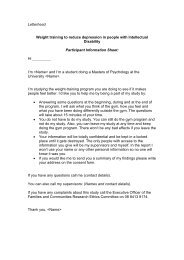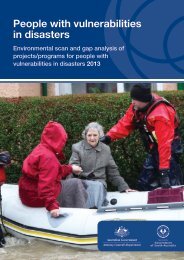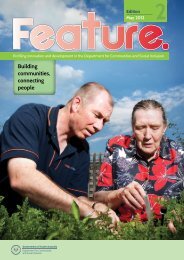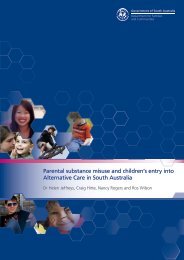Panyappi Indigenous Youth Mentoring Program Evaluation
Panyappi Indigenous Youth Mentoring Program Evaluation
Panyappi Indigenous Youth Mentoring Program Evaluation
You also want an ePaper? Increase the reach of your titles
YUMPU automatically turns print PDFs into web optimized ePapers that Google loves.
<strong>Panyappi</strong> <strong>Indigenous</strong> <strong>Youth</strong> <strong>Mentoring</strong> <strong>Program</strong> <strong>Evaluation</strong><br />
more mentors were available. Alternatively they acknowledged the resources were very<br />
limited given the need.<br />
At times the intensive nature of the work was not always appreciated, and neither was it<br />
acknowledged that many young people <strong>Panyappi</strong> works with have already been through a<br />
number of workers within a single service, or several previous services that have failed<br />
to engage them or support the family. Quick success is highly unlikely in this<br />
circumstance. Moving young people on too soon can risk sending the young person back<br />
into a repeat cycle before new patterns and family/community supports are established.<br />
Choosing to “mentor beyond the trouble zone” in order to make sustainable gains will<br />
have an impact on caseloads at any point in time, as well as over a period of time.<br />
Another external factor was that in the last 12 months mentors have been ready to<br />
increase their caseload capacity on at least two occasions, and were very keen to do so,<br />
but were faced with a dubious future regarding an accurate accounting of their budget<br />
within DHS and whether there would be further funding for the program. These<br />
situations compromised <strong>Panyappi</strong>’s ability to respond to need, and its reputation with<br />
other workers and services. It could not risk increasing caseloads when it was not<br />
possible to guarantee young people and families an ongoing service. They were aware of<br />
frustration from other program collaborators:<br />
If I don’t have a good mentor or I don’t have any mentors there is nothing I can<br />
do about it and I would rather give no mentor than give one that is not going to<br />
do the job properly because I am only damagi ng that chil d . Some departments<br />
don’t understand that. I look at the bigger picture of the effects that we may<br />
be causing so I think very seriously when I get my referrals in. I’m waiting to do<br />
a recruitment drive, but i t’s<br />
funding again. (<strong>Panyappi</strong> Coordinator)<br />
A range of mentors<br />
There was a consistent theme that having the “right staff” is critical to the success of a<br />
program that is strongly relationship based, such as mentoring. When this did not occur<br />
people told stories of relationship breakdowns and poor staff performance. When this<br />
did occur, then stories reflected all of the themes outlined in the Young people and<br />
family themes section above.<br />
Most of the mentors to date have been relatively young. This has benefits because they<br />
may have better awareness of young people’s issues, being less distant from that stage<br />
in their life, and young people may be more willing to relate to them.<br />
I think it is good having young people working with young people. They know what<br />
these young people are going through. They relate better. It’s important to have<br />
a balance. I think it would be nice to have a varied age group as mentors.<br />
(Advisory Group Member)<br />
It also may have disadvantages when young people would respond better to an older<br />
person or benefit from their increased life wisdom. Exposure to this wisdom may assist<br />
- 69 -












